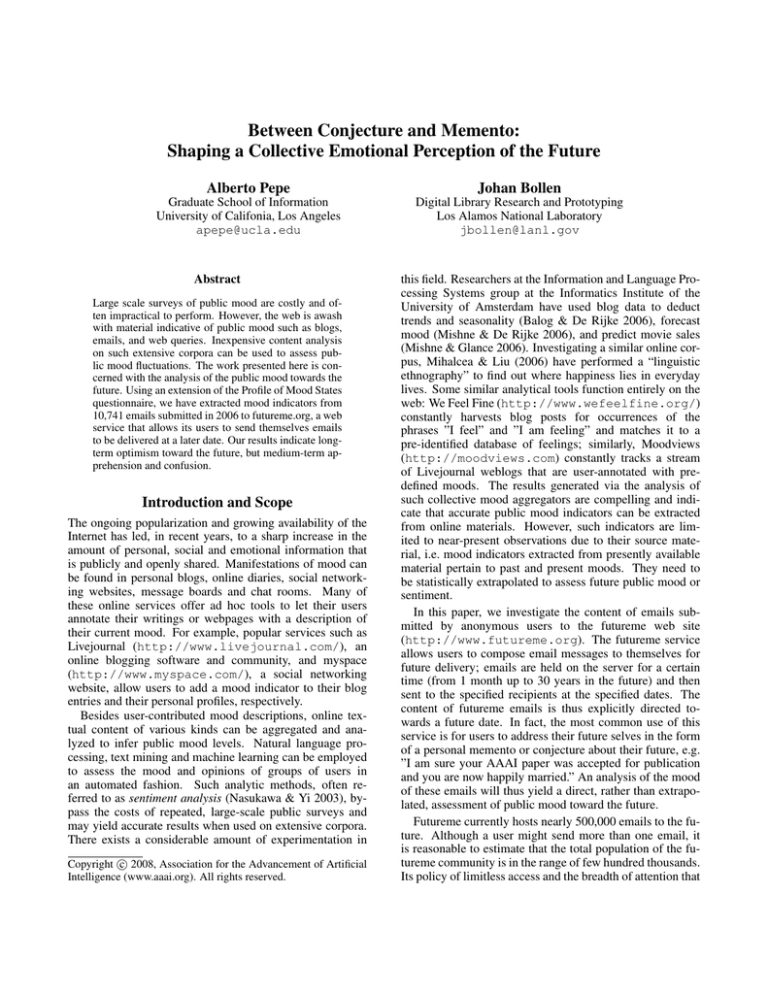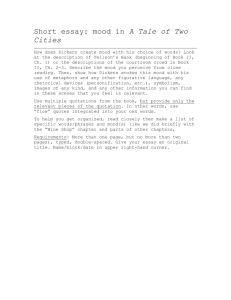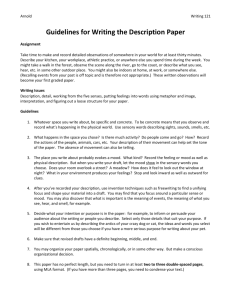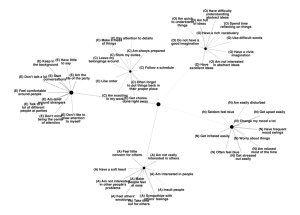
Between Conjecture and Memento:
Shaping a Collective Emotional Perception of the Future
Alberto Pepe
Johan Bollen
Graduate School of Information
University of Califonia, Los Angeles
apepe@ucla.edu
Digital Library Research and Prototyping
Los Alamos National Laboratory
jbollen@lanl.gov
Abstract
Large scale surveys of public mood are costly and often impractical to perform. However, the web is awash
with material indicative of public mood such as blogs,
emails, and web queries. Inexpensive content analysis
on such extensive corpora can be used to assess public mood fluctuations. The work presented here is concerned with the analysis of the public mood towards the
future. Using an extension of the Profile of Mood States
questionnaire, we have extracted mood indicators from
10,741 emails submitted in 2006 to futureme.org, a web
service that allows its users to send themselves emails
to be delivered at a later date. Our results indicate longterm optimism toward the future, but medium-term apprehension and confusion.
Introduction and Scope
The ongoing popularization and growing availability of the
Internet has led, in recent years, to a sharp increase in the
amount of personal, social and emotional information that
is publicly and openly shared. Manifestations of mood can
be found in personal blogs, online diaries, social networking websites, message boards and chat rooms. Many of
these online services offer ad hoc tools to let their users
annotate their writings or webpages with a description of
their current mood. For example, popular services such as
Livejournal (http://www.livejournal.com/), an
online blogging software and community, and myspace
(http://www.myspace.com/), a social networking
website, allow users to add a mood indicator to their blog
entries and their personal profiles, respectively.
Besides user-contributed mood descriptions, online textual content of various kinds can be aggregated and analyzed to infer public mood levels. Natural language processing, text mining and machine learning can be employed
to assess the mood and opinions of groups of users in
an automated fashion. Such analytic methods, often referred to as sentiment analysis (Nasukawa & Yi 2003), bypass the costs of repeated, large-scale public surveys and
may yield accurate results when used on extensive corpora.
There exists a considerable amount of experimentation in
c 2008, Association for the Advancement of Artificial
Copyright Intelligence (www.aaai.org). All rights reserved.
this field. Researchers at the Information and Language Processing Systems group at the Informatics Institute of the
University of Amsterdam have used blog data to deduct
trends and seasonality (Balog & De Rijke 2006), forecast
mood (Mishne & De Rijke 2006), and predict movie sales
(Mishne & Glance 2006). Investigating a similar online corpus, Mihalcea & Liu (2006) have performed a “linguistic
ethnography” to find out where happiness lies in everyday
lives. Some similar analytical tools function entirely on the
web: We Feel Fine (http://www.wefeelfine.org/)
constantly harvests blog posts for occurrences of the
phrases ”I feel” and ”I am feeling” and matches it to a
pre-identified database of feelings; similarly, Moodviews
(http://moodviews.com) constantly tracks a stream
of Livejournal weblogs that are user-annotated with predefined moods. The results generated via the analysis of
such collective mood aggregators are compelling and indicate that accurate public mood indicators can be extracted
from online materials. However, such indicators are limited to near-present observations due to their source material, i.e. mood indicators extracted from presently available
material pertain to past and present moods. They need to
be statistically extrapolated to assess future public mood or
sentiment.
In this paper, we investigate the content of emails submitted by anonymous users to the futureme web site
(http://www.futureme.org). The futureme service
allows users to compose email messages to themselves for
future delivery; emails are held on the server for a certain
time (from 1 month up to 30 years in the future) and then
sent to the specified recipients at the specified dates. The
content of futureme emails is thus explicitly directed towards a future date. In fact, the most common use of this
service is for users to address their future selves in the form
of a personal memento or conjecture about their future, e.g.
”I am sure your AAAI paper was accepted for publication
and you are now happily married.” An analysis of the mood
of these emails will thus yield a direct, rather than extrapolated, assessment of public mood toward the future.
Futureme currently hosts nearly 500,000 emails to the future. Although a user might send more than one email, it
is reasonable to estimate that the total population of the futureme community is in the range of few hundred thousands.
Its policy of limitless access and the breadth of attention that
Data collection and processing.
The data used in the study was obtained from the archives of
futureme, a web service that allows its users to send themselves emails to be delivered at a later date, up to 30 years
in the future. Upon submission of the email, users can decide whether to make the content of their email publicly
available. Subsequently, futureme publishes the following
information for public emails without revealing the user’s
identity: a) date of email dispatch (when the message was
written), b) textual content of email and c) intended date of
delivery (when the message is due to arrive).
Futureme has experienced significant growth in the 2004
to 2007 period. Whereas in the early years of the service
(2002), no more than 500 to 1000 public messages were
sent at a yearly basis, this number peaked at about 70,000
in 2006. At the time this analysis was conducted, complete
2007 data was not yet available although extrapolation indicates a continued yet less hyperexponential growth of the
service. For this reason, only messages submitted in 2006
were selected for further analysis. All public emails written
between January 1 and December 31, 2006 were harvested
from the futureme archive and stored in a format suitable
for textual analysis. A total of 10,741 emails were collected
for the year 2006, with delivery dates ranging from 2006
to 2036. The distributions of emails per destination year as
emails
1000
2000
3000
4000
well as the average lag between origin and destination year
are shown in Figure 1.
2006
0
futureme has recently received from the press (Moehringer
2007; Associated Press 2005) has contributed to highly diversify its user community. Nevertheless, the findings presented in this paper are based on a sample of the population
that is limited to the community of futureme users, i.e. those
that submitted their emails to the futureme website.
Although the size and characteristics of the futureme
community are unknown due its focus on user anonymity,
it clearly abides by some of the key criteria required by
the ”wisdom of crowd” phenomena as observed in finance
and prediction markets (Surowiecki 2004). In particular,
the futureme crowd manifests: a) independence (users are
not influenced by other users while composing their emails),
b) decentralization (futureme is an online, thus distributed,
community), and finally c) diversity of opinion (users write
privately to themselves).
Instead of relying on user-provided mood annotations and
ad hoc models of mood states, we used a popular psychometric instrument to extract mood indicators from the body
of futureme emails submitted in 2006, namely an expanded
version of the Profile of Mood States questionnaire (POMS)
(McNair, Loor, & Droppleman 1971). Mood indicators were
thus extracted from 10,741 emails submitted to futureme in
2006 and aggregated to query the “wise” futureme crowd to
compute collective sentiment towards forthcoming years.
The remainder of the paper is organized as follows. In the
next section we discuss the data collection process, the content of the data and some statistical facts about the data employed in the study. In the following section, we introduce
the methodology, in particular with respect to the adaptation
of the POMS test to extensive email corpora. In the last two
sections, we present and discuss our results.
2005
2010
2015
2020
2025
2030
2035
destination year
Figure 1: Email delivery date distribution for the period
2006 to 2036
The graph shows a sharp decrease in the number of emails
sent to the distant future. It is very likely that this finding reflects public pessimism about the durability of present-day
email addresses, as well as services and technology. Yet,
a basic word occurrence analysis of the email corpus under
study reveals that the aggregated email content is overall optimistic. Table 1 displays the 20 most frequent terms used in
the emails written in 2006.
count
21373
21318
15589
12747
11438
10960
9075
8669
8643
8401
word
dear
hope
love
know
life
time
happy
remember
good
year
count
8074
7931
7184
6625
6103
5974
5299
5290
4880
4679
word
right
future
really
things
better
think
email
past
birthday
today
Table 1: Twenty most recurrent terms in emails composed
in 2006, sorted by occurrence
Using a combination of manual and automated procedures, we identified and removed emails written (a) in languages other than English and (b) in unknown character encodings. Before proceeding with the content analysis, we visually inspected the email corpus to qualitatively determine
whether we could detect similarities or clear patterns in the
the nature of the messages. We could identify two broad
categories:
• conjectures: forecasts and predictions about the future,
especially with respect to personal life aspects
• mementos: purposeful reminders and recollections about
personal events that might have been forgotten with time
As the study presented here involves a large scale mood
analysis, the dichotomy presented above raised an important
issue: does an email sent to the future convey the mood of
the user at the time of writing, or the expected perception
of mood toward the delivery date? Clearly, emails to the
future may contain conjectures or mementos and thus convey mood states relating to either the email composition or
delivery date. The distinction between a “conjecture” and
a “memento” email is sometimes too subtle to be detected
via manual inspection, let alone via automated techniques.
To overcome this obstacle, we dropped this dichotomy in
favor of a more holistic approach. In particular, we treated
the emails as “confessional” time capsules: messages whose
content does not necessarily reflect present nor future mood
states, but rather a combination of the two. The results of
the study presented here must therefore be interpreted in
this light. The mood of the emails is intended as the user’s
present mood state toward the future, similar to how the
yield curve in economics reflects present expectations of future yields (Rebonato et al. 2005).
Methodology
There exist numerous psychometric instruments to assess
individual mood states and monitor their fluctuations over
time. The Profile of Mood States (POMS) questionnaire
(McNair, Loor, & Droppleman 1971) in particular has
enjoyed widespread adoption. POMS measures six dimensions of mood, namely tension-anxiety, depressiondejection, anger-hostility, vigor-activity, fatigue-inertia, and
confusion-bewilderment. It does so by having respondents
indicate on a five-point intensity scale how well each one of
the 65 POMS adjectives describes their present mood state.
The respondent’s ratings for each mood adjective are then
transformed by means of a scoring key to a 6-dimensional
mood vector. For example, the user-indicated ratings for
terms ”angry”, ”peeved”, ”grouchy”, ”spiteful”, and ”annoyed” all contribute to the respondent’s score on the POMS
”anger” scale. The POMS is an easy-to-use, low-cost instrument whose factor-analytical structure has been repeatedly
validated and recreated (Norcross, Guadagnoli, & Prochaska
2006). It has been used in hundreds of studies since its inception (McNair, Heuchert, & Shilony 2003) and has been
normed for a wide variety of populations.
To reduce the time and effort on the part of human
subjects to complete the POMS, modifications have been
proposed that have a reduced number of mood adjectives
(Shacham 1983; Cheung & Lam 2005). For the purposes of
this study, however, we seek to modify the POMS to apply
to open-ended textual material, i.e. the futureme collection
of emails. Since the vocabulary of the futureme emails cannot be controlled, the POMS was then expanded beyond its
original set of 65 mood adjectives to match the numerous
synonyms and wordings that users may choose to express
their mood. For example, whereas the original POMS would
require human subjects to rate the term ”peeved”, the author
of a futureme email could have used the term ”mad”. The
occurrence of the term ”mad” nevertheless serves as an indication of the user’s anger level. It was therefore mapped to
the POMS mood adjective ”angry”.
We extended the intial set of POMS’s 65 mood adjectives
by 793 synonyms extracted from the Princeton University’s
WordNet (version 3.0) and Roget’s New Millennium Thesaurus (First Edition). For example, the original POMS term
discouraged was assigned a set of extended terms as follows:
discouraged, beat down, caved in, crestfallen, daunted, deterred, dispirited, downbeat, downcast, glum, lost momentum, pessimistic, put off
As such, each original POMS mood adjective, referred to
as ”main”, was now associated with a set of synonyms which
we refer to as ”extended”. We will refer to the resulting extended version of the POMS test, as POMS-l. All POMS-l
mood adjectives, both main and extended, were stemmed
to a common lexical root using the Porter stemmer (Porter
1980) so that they would match different versions of the
same term occurring in a futureme emails. For example, the
email term ”angrily” whose Porter stem is ”angri” would
match the POMS adjective ”angry” since the latter would
also be Porter-stemmed to their common root ”angri”.
To assess the mood of a futureme email, its content was
matched against the POMS-l’s main and its associated extended set of mood adjectives. If an email term matched
either a main term or its extended set of mood adjectives
this lead to the corresponding main term’s score to be incremented by 1. For example, if an email contained the term
”daunted”, this term match would occur within the extended
set for the main term ”discouraged”. Consequently, the rate
of the POMS-l mood adjective ”discouraged” would be incremented by 1. Following this procedure, the content of a
particular futureme email could be mapped to a set of scores
for each of the original POMS mood adjectives, as if a human subject had individually rated each of them. The resulting scores were then converted to a six-dimensional mood
vector. This vector was normalized to unit-length.
As a result, each email was mapped to a normalized
six-dimensional POMS mood vector representing its level
of tension, depression, anger, vigor, fatigue and confusion.
These mood vectors were grouped according to the delivery date of the original email, resulting in a set of mood
state vectors for each year between 2006 and 2036. A twosided Kolmogorov-Smirnov test of significance was then
conducted between the sets of mood vectors for each pair of
years between 2006 and 2036. Statistically significant mood
changes between any two particular years (p < 0.05) could
thus be detected.
The trend lines for each of the mood dimensions were
plotted over time. Mean mood scores were converted to zscores according to the time-series mean and standard deviation to establish an equal scaling for all mood dimension
trend lines and to be able to interpret deviations from the
temporal mean. A 2-degree polynomial smoothing was applied to the raw data to elucidate long-term trends.
Results
All measured dimensions indicated mood fluctuations over
time, however, statistically significant differences at the significance level (p < 0.05) were found in the trend lines of
only two scales, namely depression and vigor.
Confusion. The confusion trend lines (Figure 3) showed
only two marginally significant differences in the near term.
In particular, confusion scores trended downward between
2009 and 2011 (p=0.088), further confirmed by an overlapping decrease between 2009 and 2016 (p=0.055).
+1sd
0
! 2011 *
! 2016 *
!2sd
!1sd
confusion (z!score)
+2sd
+3sd
Fatigue, tension and anger. These three mood dimensions do not display major fluctuations over time (Figure 2).
Some spikes can be observed in all three datasets, but since
they are not statistically significant, they have been excluded
from present discussion.
2010
2015
2020
2025
2030
2035
year
(a) Fatigue
Figure 3: Measured fluctuation of mood indicator confusion
(* p < 0.1)
Depression. We observed a statistically significant decrease in depression (Figure 4) for the near future, namely
the period 2007 to 2012 (p=0.035), followed by a sharp
uptick between 2012 and 2018 (p=0.025). Afterward, the
depression profile trends downward, however the observed
decline between 2018 and 2031 is only marginally significant (p=0.090).
( 201) ''
0
!1s+
! 2012 ''
!2s+
depression (z!score)
(1s+
(b) Tension
! 2031 '
2010
2015
2020
2025
2030
2035
year
Figure 4: Measured fluctuation of mood indicator depression (* p < 0.1, ** p < 0.05)
(c) Anger
Figure 2: Measured fluctuation of mood indicators fatigue,
tension and anger.
Vigor. Vigor (Figure 5) follows, as expected, an inverse pattern to depression. A highly significant increase in
vigor scores was observed between the period 2007 to 2016
+1sd
+ 2016 **
−1sd
0
vigor (z−score)
+2sd
+3sd
(p=0.0042) and a marginally significant decrease between
2016 and 2026 (p=0.085).
− 2026 *
2010
2015
2020
2025
2030
2035
year
Figure 5: Measured fluctuation of mood indicator vigor (*
p < 0.1, ** p < 0.05)
Conclusions
What have we learned from the analysis of a set of personal
emails intended to be sent to the future? No statistically
significant mood trends have been detected for the fatigue,
tension and anger dimensions of the POMS. This could be
attributed to either the failure of the POMS-l to detect such
changes or to the stability of these mood indicators over
time. It could in fact be argued that mood dimensions such
as ”fatigue” are not appropriate indicators of public mood toward the future. However, it is nevertheless conceivable that
levels of tension and anger can change in the public mood
towards the future, but our results did not provide reliable
indications of changes in these mood dimensions.
The POMS-l did however detect statistically and
marginally significant differences among the ”confusion”,
”depression” and ”vigor” mood scores of emails directed
at specific future dates. The significance values corroborate the generated trend lines shown in Figures 3, 4 and
5. Marginally significant statistical differences were found
in the ”confusion” dimension over time. These differences
suggest that confusion trends downward in the short time
(2009-2011) and increases in the near long term (20092016). This fits our intuitive understanding that the near
term future is more predictable and therefore less confusing than the long term future. However, we warn that the
observed differences are only marginally statistically significant (p < 0.1). Statistically significant differences were
observed for the depression and vigor indicators over time.
In particular, depression trends downward for the near future
and back up for the 4 year period between (2012 and 2018).
The following decrease in depression was only marginally
statistically significant, but the overall pattern seems to be
one where the futureme community in the mean is optimistic
for the short term but less so in the medium term particularly
the period between 2012 and 2018. The ”vigor” indicator
seems to follow an inverse pattern where vigor increases in
the short term but decreases in the long term.
The public mood of 30,000 futureme users thus indicates
a mixed picture. The collective mood of this user crowd towards the near term future is optimistic, whereas the long
term picture is one that seems to indicate a moderate increase in ”depression” and a moderate decrease in ”vigor”.
This effect could be tied to the intrinsically personal and intimate nature of the futureme messages. Whereas individuals
feel in control and optimistic about their personal prospects
in the near future, they may experience apprehension over
their own long-term prospects and the world, in general.
These results point to the possibility of extending a tried
and true psychometric instrument such as the POMS to assess the public mood from plubic collections of messages
directed towards future dates. More efforts need to be dedicated to further validating the proposed POMS-l and increasing its sensitivity. This would however necessitate either the
availability of more extensive collections such as the entire
futureme body of messages, or a validation effort involving
traditional psychometric evaluation measures. Another interesting venue of research would be the validation of our
results to other ”wisdom of crowds” indicators such as the
yield curve in economics and large-scale public surveys.
Acknowledgments
We would like to thank Jay Patrikios and Matt Sly for letting
us harvest and use the futureme.org public email archive.
Also, many thanks to Jean-François Blanchette and Mark
Hansen of University of California, Los Angeles for their advice and assistance throughout the early phase of this work.
References
Associated Press.
2005.
Back to the
future e-mail.
Wired.
Retrieved from
www.wired.com/culture/lifestyle/news/2005/12/69870
on October 10, 2007.
Balog, K., and De Rijke, M. 2006. Decomposing bloggers’
moods. In World Wide Web Conference.
Cheung, S. Y., and Lam, E. T. C. 2005. An innovative
shortened bilingual version of the profile of mood states
(poms-sbv). School Psychology International 26(1):121–
128.
McNair, D.; Heuchert, J. P.; and Shilony, E. 2003. Profile of mood states. Bibliography 1964–2002. Multi-Health
Systems.
McNair, D.; Loor, M.; and Droppleman, L. 1971. Profile
of mood states.
Mihalcea, R., and Liu, H. 2006. A corpus-based approach
to finding happiness. In AAAI 2006 Spring Symposium on
Computational Approaches to Analysing Weblogs.
Mishne, G., and De Rijke, M. 2006. Capturing global
mood levels using blog posts. In AAAI 2006 Spring Symposium on Computational Approaches to Analysing Weblogs.
Mishne, G., and Glance, N. 2006. Predicting movie sales
from blogger sentiment. In AAAI 2006 Spring Symposium
on Computational Approaches to Analysing Weblogs.
Moehringer, J. 2007. Dear me. Los Angeles Times. Retrieved from www.latimes.com/futureme on October 10,
2007.
Nasukawa, T., and Yi, J. 2003. Sentiment analysis: capturing favorability using natural language processing. In
K-CAP ’03: Proceedings of the 2nd international conference on Knowledge capture, 70–77. New York, NY, USA:
ACM Press.
Norcross, J. C.; Guadagnoli, E.; and Prochaska, J. O. 2006.
Factor structure of the profile of mood states (POMS):
Two partial replications. Journal of Clinical Psychology
40(5):1270 – 1277.
Porter, M. F. 1980. An algorithm for suffix stripping. Program-Automated Library and Information Systems 14(3):130–137.
Rebonato, R.; Mahal, S.; Joshi, M.; and Bucholz, L. 2005.
Evolving yield curves in the real-world measure: a semiparametric approach. Journal of Risk 7(3):29–62.
Shacham, S. 1983. A shortened version of the profile of
mood states. Journal of Personality Assessment 47(3):305–
306.
Surowiecki, J. 2004. The Wisdom of Crowds. Doubleday.






